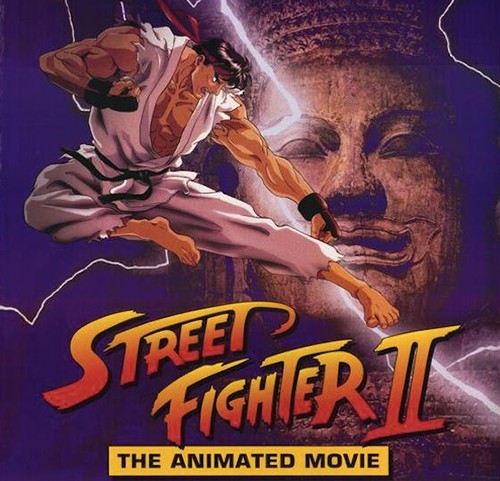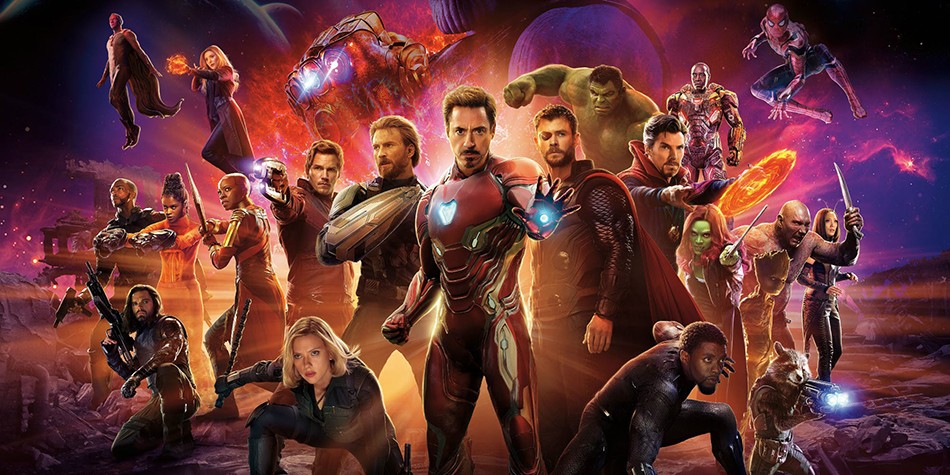Animated Action Packs A Punch in Street Fighter II (1994)

By the early 1990’s, arcades were in a massive decline. Once the haunt of choice for the video game obsessed amongst us, their lure gradually diminished owing to the rise in popularity in home consoles. Why spend your precious quarters in a nasty old arcade, when you can sit at home and game in the comfort of your own home?
But then, in 1991, Capcom released a game that would change all that. Gamers hurried back to the arcades in their droves to bear witness to a game that simply had to be seen to be believed. That game was Street Fighter II. Featuring a colourful and diverse cast of characters, stunning global locations, a thumping soundtrack, and intense fighting action, the game was a massive success. From that point on, it was impossible to walk past an arcade without hearing shouts of “Hadoken” or “Sonic Boom” emanating from the machines within.
With a sure-fire money maker like this, it was only a matter of time before Hollywood came calling, and they did in 1994 with their Jean-Claude Van Damme led take on the series. Before this exploded into cinemas, Japan launched their own cinematic take on the franchise: Street Fighter II: The Animated Movie.
Video Game to Video Cassette

Of all the different types of video games to attempt to adapt to movies, fighting games may be the most difficult. They’re low on story, and the majority of them lack a central character. Even if they do, that character may be far from your favourite. Sure, Ryu may be the Street Fighter brand’s flagship character, but Guile has always been my character of choice whenever a controller was thrust into my hands. Street Fighter II: The Animated Movie handles this problem quite well.
As the game itself had no real story to speak of, neither does the movie. The threadbare plot of Bison seeking to track down the world’s greatest fighters and brainwash them to become assassins for his terrorist Shadaloo organisation, is simply a means to an end to justify pairing characters up for some incredible fight scenes. The issue of having a primary character is solved by utilising five of the series top characters in starring roles. Ryu, Ken, Chun-Li, Guile and M. Bison run the show here.
Fear not though, as every Street Fighter II character gets a look in in this movie, including the four newer characters introduced in the Super Street Fighter II: The New Challengers game, and all of them get their own kick ass fight scene. Except for T. Hawk. He straight up gets his ass handed to him, but that’s okay because nobody likes that character anyway. Nobody.
All the Trademark Moves
Though the video game series relied heavily on special moves, they’re notably absent for the most part here. Sure, Ryu will throw a fireball and Ken will let loose with a Dragon Punch, but they’re used quite sparingly in the movie. Unlike the majority of action anime, a heavy dose of reality can be found in all of the fights throughout the movie.
Punches and kicks all look to carry some serious weight, and the movie does not shy away from showing us what happens when a particularly nasty one connects. Noses are pulped and teeth are sent flying. Such brutal fights can be attributed to the movie’s producers hiring K-1 founder Kazuyoshi Ishii and the late, great fighter Andy Hug to choreograph all of the fight scenes. Their experience shows and lend the fights a much needed sense of realism in a movie that is otherwise completely off the wall.
Kudos must go to the animators too for capturing the likenesses and fighting styles of the characters so well. Long time fans will easily recognise and chuckle to see many of the characters’ trademark moves, from Zangief’s Spinning Piledriver, Blanka’s Electric Thunder, to T-Hawk lying unconscious on the ground after having the snot beaten out of him. Precious memories.
Epic Fight Scenes

The movie is loaded with epic fight scenes (Ryu vs. Sagat, Ryu vs. Fei Long, Zangief vs. Blanka, T. Hawk vs. gravity), but the best and most brutal by far is the epic confrontation between Chun-Li and Vega. An ominous mood is set just before the fight begins, with Vega creeping through Chun-Li’s apartment while she has her now infamous and much celebrated shower scene. I’m sure many men of a certain age will look back on this scene with fond memories.
Once the fight begins, it is a hectic affair. Vega springs from the ceiling, with Chun-Li rapidly backing away. The fact that the fight takes place in such a confined setting really adds to the frantic feel. All action takes place in close quarters, leaving Chun-Li with no place to run. For a lot of the showdown, she is literally fighting with her back to the wall. This close proximity causes both fighters to use some of their character specific moves from the game, a fact that will delight long-time gamers and go over the heads of pretty much everyone else.
Vega climbs to a higher vantage point, looking for an opportunity to strike, just like he does in the games, while Chun-Li uses the walls to propel herself towards her would-be attacker. It’s fast, it’s frantic, and it’s pure Street Fighter. It must be said that the music plays a major part in this fight scene and is almost a character in itself. The use of the song “Ultra” by German group KMFDM is an exceptionally hard-hitting piece of music and perfectly matches the relentlessness of the serpentine Vega as he closes in on his prey. Watching Chun-Li fend off Vega, her vision blurring owing to blood loss, while Guile and his ridiculous haircut tear up the New York City streets in his souped-up muscle car in a desperate attempt to come to her rescue will have any viewer on the edge of their seats. Truly fantastic filmmaking.
The Sound of Violence
Indeed, the whole musical score for the entire movie is most excellent. It is a soundtrack very much inspired by the grunge scene of the time, so bands like Korn, Silverchair and Alice in Chains all feature heavily on the soundtrack. Watching Ken weave his red convertible in and out of traffic while Them Bones plays in the background is like being Hurricane Kicked a quarter century into the past. Man, I miss the 90s. The choice of music is so important to this movie and really helps in creating the perfect mood for each scene. I hate to go back to talking about the Chun-Li vs. Vega fight again (that’s a lie, I could wax lyrical about that epic showdown all the doo-dah day), but it is a prime example of how the music adds to the aggressive tone of the movie. This is quite easy to prove. Two different versions of the movie exist; a Japanese version and a Western version.
The Japanese soundtrack is filled with more dulcet J-Pop tracks, which give a totally different vibe to the movie. The aforementioned Chun-Li/Vega fight comes across as perhaps more creepy and unsettling in the Japanese version, whilst the Western version just screams out and out carnage. Watching Vega bear down on Chun-Li while the singer shrieks “Give it to me!” is an intense experience. Your mileage may vary, but I much prefer the edition we got here in the west. Beyond the soundtrack, the voice acting is pretty standard fare, with all characters sounding pretty much as you’d expect them to.
I’m no anime purist, so the English voices suited me just fine. This being a 90’s anime, you’ll recognise the voices from a ton of other anime fare, the pool of utilized voice actors utilized being quite small at the time. They all do a bang-up job though. And Breaking Bad’s very own Bryan Cranston voices Fei-Long! How cool is that!? It’s a little-known fact that he did voicework for shows like Mighty Morphin’ Power Rangers back in the 90’s, and he adds a real gravitas to Fei-Long here.
Compared to the Live Action Version

And so comes the time when the question must be asked, is this animated classic better than Van Damme’s live action version? It’s really not fair to compare the two, as they’re both very different movies. This anime is a hard-hitting action movie, while Van Damme’s outing is a far more family friendly affair.
Overall though, I’m gonna have to award the victory to Street Fighter II: The Animated Movie. It does a better job in handling the source material, does justice to all your favourite street fighters, has epic fight scenes and a rocking soundtrack. At least we can all agree that both these movies are miles better than the ultimate guilty pleasure that is Street Fighter: The Legend of Chun-Li. Let us all find common ground and take solace in that.
Street Fighter II: The Animated Movie certainly left more of a mark on the Street Fighter games that followed it though than wither of the other two movies. The Street Fighter Alpha games, the pinnacle of the series as far as I’m concerned, were heavily influenced by this movie. The origin of Ryu’s red headband (a headband second only to that of John Rambo) is introduced here and became canon for how he acquired it in the games also. The bulkier and more menacing design of Bison made its way into the games also, as did the film’s epic final confrontation with Ryu and Ken teaming up against the evil dictator. Renamed Dramatic Battle for the games, it is incredible fun to team up with a buddy and Dragon Punch your way to victory.
An Ultimate Action Anime

All in all, Street Fighter II: The Animated Movie is a solid gold classic. It’s certainly dated by today’s animation standards, but I feel that this adds to its charm. The animation and the soundtrack make this an unapologetically 90’s experience, and that’s no bad thing. I owe a lot to this movie. It was the first adult anime I ever saw, and it showed me that I did not have to leave animation behind as I grew older, rather, the animations I watched could become more adult and mature as I did too.
This movie was a gateway to anime for me, and led me to such classics as Ghost in the Shell and Katanagatari, and I’ll be forever grateful to it for that. From the moment Ryu throws his first fireball before the opening credits have finished rolling, you’ll have the feeling that what you’re about to watch is special indeed.
When the chills hit you when you see Bison stalking through his base, flanked by Vega, Sagat and Balrog a scant few minutes later, this premonition will be confirmed. If nothing else though, it’s 100 odd minutes of ass kicking entertainment that anyone, gamer or otherwise can enjoy. Unless you’re a T. Hawk fan.
A childhood spent watching Jean-Claude Van Damme kick people in the face led to Dan Shanahan becoming the well-adjusted human being and all-around nice guy he is today. Having spent the majority of his twenties kicking ass, taking names, but mostly teaching English in Japan, he now resides in his native Ireland. He lives in constant fear that a team of ninjas may have followed him home and now secretly share his house with him.
Let us know what you think in the comments or on our Facebook page!









